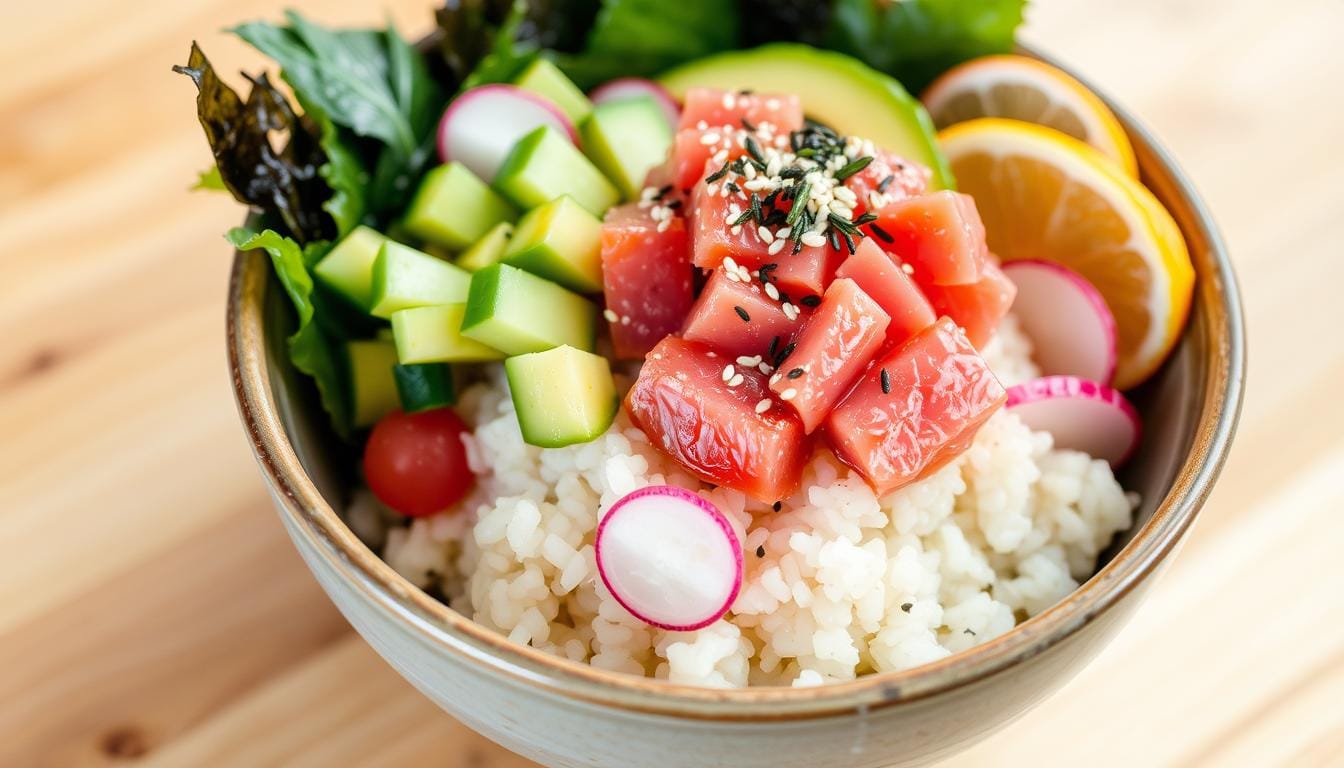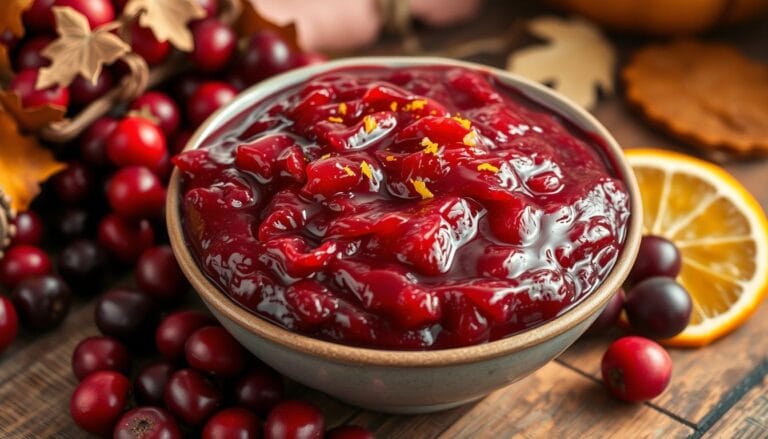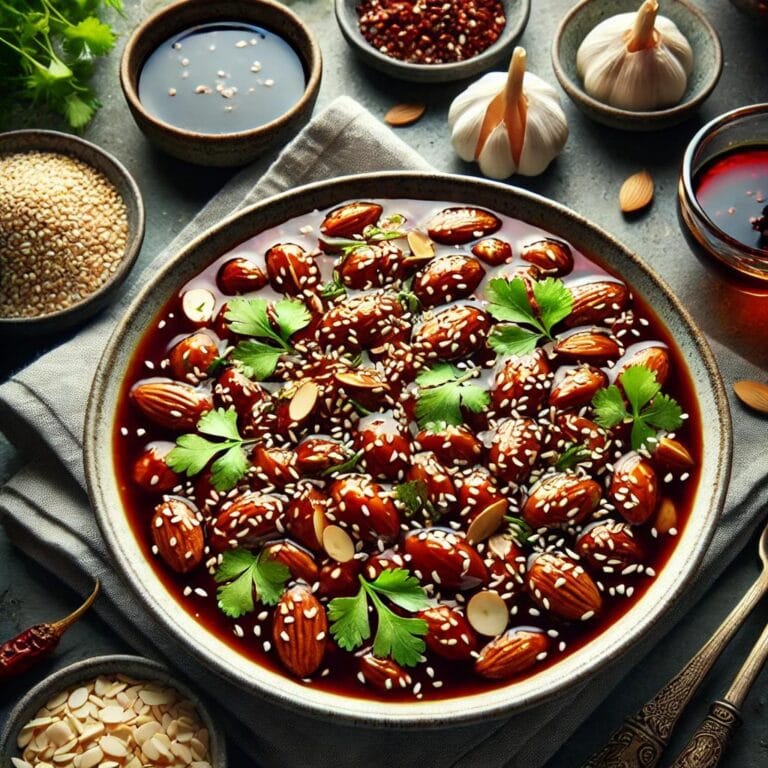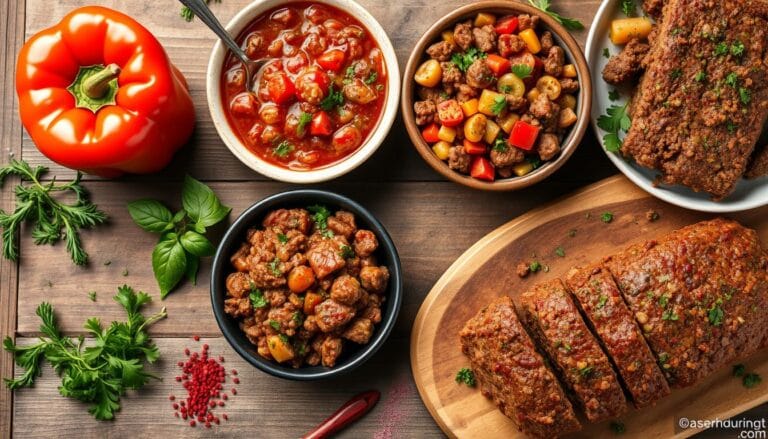Quick & Easy Poke Bowl Recipe No Soy Sauce
As a busy working mom, I’m always searching for healthy, tasty meals that are quick to make. That’s why I fell in love with poke bowls. They’re inspired by Hawaii and are full of fresh flavors. Plus, you can make a soy-free version in just 15 minutes!
Table of Contents
Understanding Traditional Poke and Soy-Free Options
Poke, a dish from Hawaii, has become popular worldwide. It started with raw fish, like tuna or salmon, mixed with sea salt, seaweed, and nuts. Now, many poke bowls use soy sauce, which is a problem for those with soy allergies.
Origins of Hawaiian Poke
Poke’s history goes back to ancient Hawaiian times. Fishermen seasoned their catch with local ingredients. This kept the seafood’s natural taste. Later, soy sauce became a part of poke, known as “ahi shoyu poke” in the 1970s.
Why Choose Soy-Free Poke
People with soy allergies or those on a soy-free diet can’t have traditional poke. Soy-free poke bowls are a tasty choice. They let you enjoy seafood without soy risks.
Health Benefits of Poke Bowls
Poke bowls are nutritious, whether they’re traditional or soy-free. They mix protein, healthy fats, and veggies for lots of nutrients. You can make them fit your diet, making poke bowls a healthy choice.
Essential Ingredients for Your Soy-Free Poke Bowl
Making a tasty poke bowl recipe no soy sauce starts with picking the right ingredients. The main protein can be fish like tuna or salmon, or plant-based options like tofu. Choose a base of white rice or greens for a solid foundation.
Add crunchy veggies like cucumber and radish for texture. Avocado and mango or pineapple bring sweetness. Top it off with sesame seeds, onions, or seaweed for extra flavor.
For the dressing, avoid soy sauce and go for a soy-free version. Mix sesame oil, rice vinegar, garlic, ginger, and a bit of sriracha for a tangy, savory taste.
| Essential Poke Bowl Ingredients | Recommended Options |
|---|---|
| Protein | Tuna, Salmon, Tofu, Tempeh |
| Base | White Rice, Brown Rice, Quinoa, Greens |
| Vegetables | Cucumber, Radish, Purple Cabbage, Edamame |
| Fruits | Avocado, Mango, Pineapple |
| Toppings | Sesame Seeds, Crispy Onions, Seaweed |
| Sauces | Sesame Oil, Rice Vinegar, Garlic, Ginger, Sriracha |
With the right ingredients and bold flavors, you can make a fantastic poke bowl recipe no soy sauce. It’s a fresh, healthy, and delicious meal.
Selecting the Perfect Protein Options
Choosing the right protein is key to making a great ahi tuna poke or raw fish poke bowl. Hawaiian poke often uses ahi tuna and salmon. But, you can also try other proteins for different tastes or dietary needs.
Fish Varieties for Poke
- Ahi tuna (yellowfin or bigeye)
- Salmon
- Octopus
It’s important to pick sushi-grade fish for your poke bowl. This ensures it’s safe and fresh. A tasty, soy-free marinade can make your poke even better.
Alternative Protein Choices
- Cooked chicken or shrimp: These are great if you like cooked protein. They add a nice twist to your poke bowl.
- Tofu: Firm or extra-firm tofu works well for a veggie or vegan poke bowl.
- Canned tuna: It’s quick and easy to use as a raw fish substitute.
Proper Protein Preparation
How you prepare your protein matters for safety and flavor. Clean and cut the fish, poultry, or tofu into small pieces. A good marinade can really boost your poke bowl’s taste.
| Protein | Preparation | Flavor Profile |
|---|---|---|
| Ahi Tuna | Sushi-grade, diced | Mild, delicate |
| Salmon | Sushi-grade, diced | Rich, slightly oily |
| Chicken | Grilled or poached, diced | Lean, versatile |
| Tofu | Firm or extra-firm, marinated | Neutral, absorbs flavors well |
Base Options and Rice Preparation
The base of a poke bowl is key, with choices like white or brown rice, quinoa, or cauliflower rice. For a true Hawaiian poke taste, sushi-grade rice is best. It offers the right texture and flavor.
To cook the rice right, follow the package directions. You can also use instant or frozen rice for a quick fix. Make sure the rice is warm or at room temperature. This helps it mix well with the cold poke ingredients.
| Rice Base | Preparation Time | Serving Suggestions |
|---|---|---|
| Sushi Rice | 20-25 minutes | Traditional poke bowl, sushi burgers |
| Jasmine Rice | 15-20 minutes | Poke bowls, rice salads |
| Cauliflower Rice | 5-10 minutes | Low-carb poke bowls, salad bases |
| Quinoa | 15-20 minutes | Poke bowls, grain bowls |
For a healthier choice, try a salad base with mixed greens like kale or spinach. These greens add a fresh, crunchy touch to your poke bowl. They also enhance the poke’s delicate flavors.
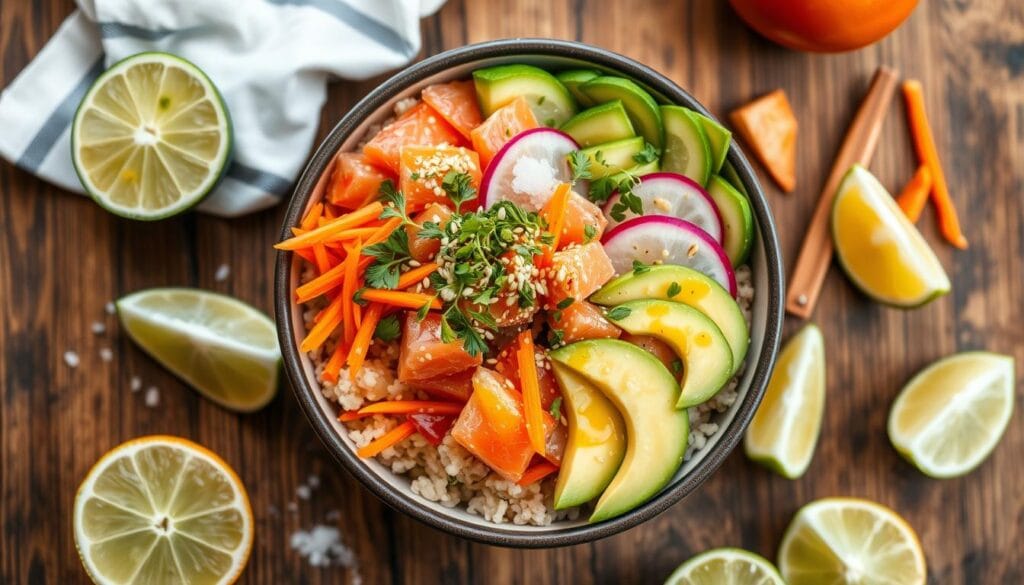
Fresh Vegetable and Fruit Components
Creating a healthy poke bowl is all about the fresh veggies and fruits. They boost the dish’s nutrition and look. These ingredients add crunch, flavor, and color. They also pack vitamins, minerals, and antioxidants for better health.
Essential Fresh Toppings
- Cucumber: It’s crisp, refreshing, and hydrating. Cucumber adds a nice texture to the healthy poke bowl.
- Avocado: Avocado is creamy and full of nutrients. It’s a great source of healthy fats and fiber.
- Green Onions: They have a mild onion taste and a bright green color. Green onions add a fresh touch.
Optional Add-ins for Extra Flavor
- Mango: Mango brings a sweet and tangy flavor. It adds a tropical twist to the healthy poke bowl.
- Edamame: Edamame is packed with protein, fiber, and is low in calories. It’s a nutritious and filling choice.
- Pickled Vegetables: Pickled veggies like radish or red cabbage add a tangy crunch. They contrast well with other flavors.
These fresh ingredients make the healthy poke bowl look and taste great. They ensure a balanced and nutritious meal. By using seasonal produce, you get the best flavors and support local farmers. Plus, it’s better for the environment.
Poke Bowl Recipe No Soy Sauce: Step-by-Step Guide
Making a tasty poke bowl without soy sauce is simple! Just follow this easy guide to make a healthy, flavorful poke bowl at home. The secret is in the marinade and choosing the right base and toppings.
- Begin by cooking your rice or grain base. Use Tilda® Steamed Jasmine Rice for a fragrant, fluffy base.
- While the rice cooks, prep your protein. For this poke bowl recipe no soy sauce, air-fried salmon is used. Marinate it in chili miso sauce, maple syrup, and tamari for 15-20 minutes. This adds bold, umami flavors.
- While the protein marinates, chop your veggies. Dice cucumbers, shred carrots, and slice green onions for crunch and freshness.
- Make the spicy mayo sauce by mixing mayonnaise and sriracha. This creamy, zesty sauce brings all the flavors together.
- Assemble your poke bowl by layering rice, marinated salmon, and chopped veggies. Top with spicy mayo sauce and garnish with toasted sesame seeds.
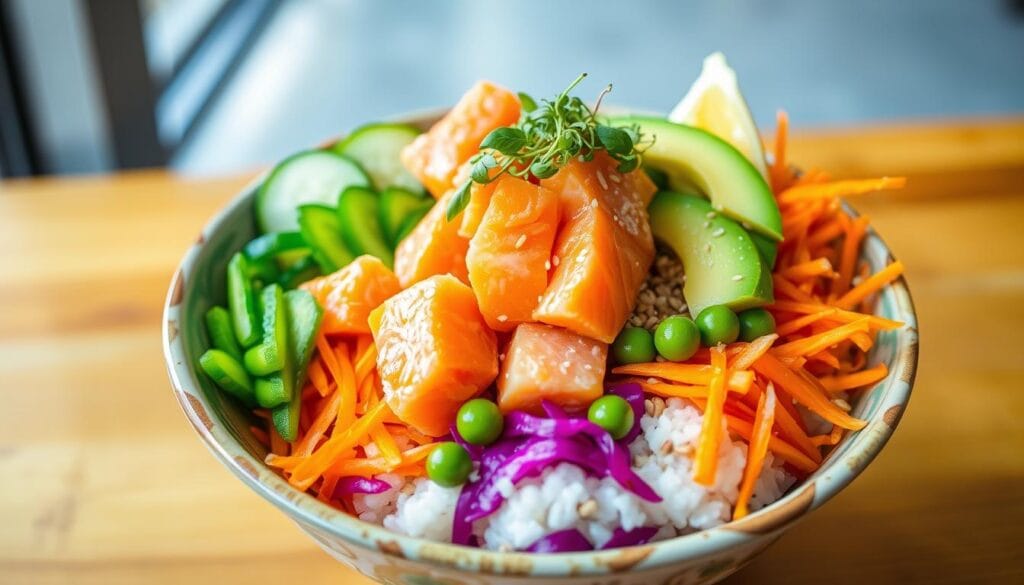
Enjoy your poke bowl recipe no soy sauce right away for the best taste and texture. This dish is not only yummy but also full of nutrients like omega-3s, lean protein, and vitamins. Feel free to customize it with different proteins or extra toppings like edamame, avocado, or pickled onions.
Creating Flavorful Soy-Free Marinades and Sauces
Making the perfect poke bowl is more than picking the right protein and ingredients. The marinade and sauces are key. They add delicious flavors to every bite. Try these tasty soy-free dressings to make your poke bowl stand out.
Spicy Mayo Recipe
Spicy mayo is a favorite for poke bowls. Mix mayonnaise with sriracha or hot sauce to get the right heat. The creamy mayo and spicy kick make a great taste mix that goes well with fresh poke.
Alternative Sauce Options
There are many soy-free sauces to try. Coconut aminos are sweet and savory, like soy sauce but without soy or gluten. You can also use a rice vinegar dressing with sesame oil, ginger, and garlic for a tangy flavor. Lemon or lime oils add a fresh, zesty taste.
When using any soy-free sauce, taste and adjust the flavors. The goal is to find the perfect mix that complements the poke and other ingredients. With a bit of creativity, you can make a unique and tasty soy-free poke bowl.
| Soy Sauce Alternative | Description | Key Features |
|---|---|---|
| Tamari | A darker, richer form of Japanese soy sauce | Gluten-free, unique flavor profile |
| Coconut Aminos | A slightly sweeter alternative to soy sauce | Soy-free, gluten-free, MSG-free |
| Eel Sauce | A thicker, sweeter sauce commonly used as a glaze | Versatile in various dishes |
| Liquid Aminos | A soy sauce alternative with less sodium | Gluten-free, versatile ingredient |
| Worcestershire Sauce | A complex, savory-sweet sauce | Suitable soy sauce substitute |
| Ponzu Sauce | A tangy Japanese condiment with citrus and soy flavors | Provides a zesty tang in recipes |
| Teriyaki Sauce | A Japanese BBQ sauce with a savory-sweet profile | Common soy sauce alternative |
Exploring soy-free marinades and sauces opens up a world of flavors for your poke bowls. It meets different dietary needs and tastes.
Assembly Tips and Presentation Techniques
Making the perfect hawaiian poke bowl is more than just picking the right ingredients. How you put it together and present it can really make a difference. Here are some easy tips to make your poke bowl stand out and delight everyone’s senses.
- Arrange the ingredients in a circular pattern for a visually appealing display. This not only looks stunning but also makes it easy for diners to access all the components.
- Utilize contrasting colors and textures to create a visually interesting poke bowl. Bright greens, vibrant reds, and creamy avocado pair beautifully with the firm texture of the protein.
- Serve your poke in wide, shallow bowls that allow the ingredients to shine. This makes it easier for your guests to scoop up all the flavors in each bite.
- Keep wet ingredients like the protein and any sauces separate from the dry toppings until just before serving. This ensures your poke bowl stays fresh and crisp.
- Finish your masterpiece with garnishes that add a final touch of elegance. Sprinkle on some toasted sesame seeds, julienned nori, or fresh microgreens for a stunning presentation.
By following these simple tips, you’ll create a hawaiian poke bowl that’s not just tasty but also looks amazing. Impress your guests and satisfy their cravings with this easy-to-make, flavor-packed dish.
Storage and Meal Prep Guidelines
Making healthy poke bowls is easy, but storing and prepping meals right can make it even better. Follow a few simple steps to keep your poke bowl ingredients fresh and flavorful until you eat them.
It’s smart to store your ingredients separately. Cooked rice and proteins like salmon can stay good in the fridge for up to 3 days. But add fresh veggies just before serving to keep them crunchy. Don’t freeze assembled poke bowls, as it can ruin their texture and taste.
For easy meal prep, spend some time on the weekend getting your poke bowl parts ready. Cook the rice, marinate the protein, and chop the veggies. Put each part in an airtight container in the fridge until you’re ready to make your healthy poke bowl. This saves time and makes sure you have a healthy meal ready when you need it.
When it’s time to eat, just layer your ingredients in a bowl and add your favorite sauces or dressings. Keep the sauces separate until the end to avoid a soggy poke bowl. With a bit of planning, you can enjoy a healthy poke bowl any day.
| Ingredient | Storage Duration |
|---|---|
| Cooked Rice | Up to 3 days in the fridge |
| Cooked Salmon | Up to 3 days in the fridge or 3 months in the freezer |
| Chopped Vegetables | Up to 4 days in the fridge |
| Assembled Poke Bowl | Do not freeze, best enjoyed fresh |
“The key to enjoying a delicious and healthy poke bowl is to keep the components fresh and vibrant until serving time.”
Customization Ideas and Variations
Poke bowls are great because you can make them your own. For those who don’t eat meat, try using tofu or tempeh. If you’re watching carbs, use cauliflower rice or greens instead of regular rice.
Dietary Modifications
Make poke bowls fit your diet by choosing gluten-free or dairy-free options. Try using grilled chicken or shrimp for a new flavor. Add your favorite herbs and spices to make it just right for you.
Seasonal Adaptations
Use fresh, local ingredients with the seasons. In winter, add hearty veggies. In summer, try fresh fruits and greens. This keeps your meals exciting and supports local farmers.
Have you tried our recipes and liked them? Leave us a review
There are no reviews yet. Be the first one to write one.
